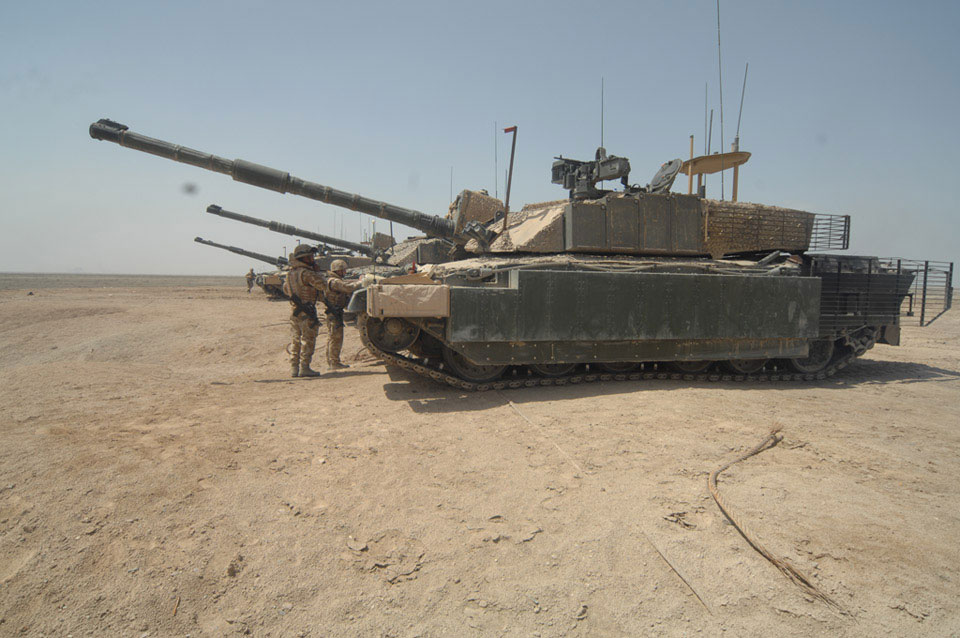

However, due to the lack of IR searchlights, they were fitted with white lights projectors, missing all but the more elementary night vision equipment. There are also arguments about a better track protection against sand and mud, thus allowing to reduce the numbers of shock absorbers. According to US intelligence, however, a few were equipped with Belgian-made thermal sights. Like the “Saddam”, a local-built searchlight was added on the right-hand-side.

All the electronics left were removed except for a few still fitted to the laser rangefinder. In addition, rubber skirts of local manufacture were also added. The Asad Babil’s side armor had 60 mm protection, 300 mm for the turret, and the flat rear was 45 mm thick. Another appliqué armor plate was also added to the rear. Externally, these are difficult to separate from the regular Saddam/T-72Ms, but the local “upgrades” consisted of 30 mm cast armor plates or frail quality forged from mild steel (no longer laminated RHA), bolted-on the glacis armor plate, leaving, in theory, an equivalent air gap in between to dissipate a HEAT (High Explosive Anti-Tank) jet. In short, the Asad Babil was a rushed and cheap downgrade of the already downgraded Saddam MBT, itself derived from the downgraded T-72M export model. These even poorer quality tanks were the Asad Babil tanks. However, according to Russian intelligence, at least 100 tanks (250, according to other sources) were nevertheless assembled, with ever more concessions, and delivered in the meantime, or after the embargo, which tells about the quality of these deliveries. Critical parts were missing for the completion of the last batches of Saddams. Following the Iraqi invasion of Kuwait in 1990, a new UN embargo, far more strict, was passed, which banned everything but the smallest supply parts to maintain existing Iraqi tanks. However, this production was not to last. More significantly, the Saddams were downgraded for desert warfare, as some of the suspension’s shock absorbers were removed. The first assembled T-72M was released in early 1989, and called “Saddam”, without notable changes compared to the regular T-72M1 but perhaps had lowered steel quality, some electronics omitted, and the fitting of an obsolete IR searchlight. The factory already had experience in refitting and overhauling badly damaged T-54/ 55s and T-62s. The first supposed all-Iraqi MBT was assembled with such parts in a German-built 1986 steel factory near Taji, north of Baghdad. This did, however, not prevent local production, thanks to Czech-built, Polish, and also, perhaps, Soviet T-72M1 parts smuggled through the embargo.Ībandoned T-72M1/Asad Babil in Iraq, 2003 Unfortunately, in 1989, the UN banned all arms exports to Iraq. 60 were lost in this war, but these were apparently up to the job, and Saddam asked for many more.

Nevertheless, Saddam Hussein ordered 100 of T-72M1s after the start of the Iran-Iraq War (1980-1988).

There are also clues that its armor composition was far less refined than on the original T-72B. It had also no ATGM capabilities, and its autoloader was simplified and slower. As a result, the T-72M1 lacked a laser range finder, electronic ballistic computer, any kind of sensors, and was fitted with a “fresh-from-storage” 1960s-era night vision equipment. For that reason, the T-72M was, by all standards, a far downgraded T-72. With the T-72M (nicknamed “ Monkey” by western intelligence), the only way to achieve the best deal was to cut out as many technical features as engineers could, especially when targeting the Middle East and its export market. Enormous technological gaps existed between the T-72, and other cheap and commonly exported tanks such as the revolutionary T-64 (which passed many technologies onto the T-72), and the affordable, but primitive, T-55. The T-72M was simply not as sophisticated as the standard, non-export model. However, the T-72M, which was developed solely for export, was not as advanced. The introduction of the “ Dolly Parton” composite frontal armor made it literally impregnable to the widely-used 105 mm guns on tanks fielded by NATO and SEATO nations, but also the 105 mm used by China. The Soviet T-72 was one of the best tanks in the world back in the 1970s.


 0 kommentar(er)
0 kommentar(er)
